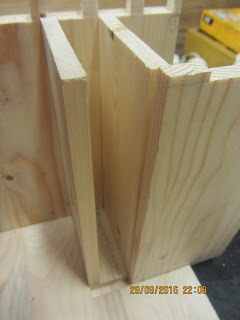I have never really understood the idea of it, and never liked it much either.
I figured that it has been a while since I have made any secret compartments, and this project can easily accommodate one.
The design is similar to a secret compartment I saw in a blanket chest article some years ago. The idea is to make a small fixed interior till wit a secret compartment below it. To gain access, one will have to lift up the vertical part of the till.
I first laid out the positions of the parts of the till and the extra space below it. I then used a batten to help guide my Japanese saw when sawing out the sides of the grooves and dadoes.
The bulk of the waste was removed using a chisel, and my small homemade router next ensured a consistent depth.
To avoid the possibility to accidentally pulling out the front of the till, I made some deeper dadoes for the lower part of it. The front itself has got two small protrusions that will fit in there.
To determine the actual length of the till parts, I made a dry assembly of the box and took the measurements directly from it.
After processing those parts, I made another dry assembly to check if all worked as it should.
The system is OK, but I need to make a small chamfer at the ends of the till bottom and the secret compartment bottom.
When that is done I guess the next step is to sand the box lightly on the inside to remove some of the grime that almost inevitably comes from working in an engine room workshop, before gluing up the case.
Finding the correct length.
The layout of the secret compartment when closed.
The secret compartment opened.
The deeper dado and the protrusion on the front of the till.
Dry assembly closed.
Dry assembly opened.

























